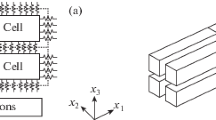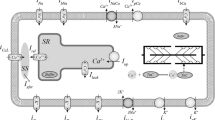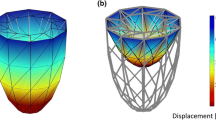Abstract
Mechanical changes in the heart muscle can influence its electrical properties through a process called mechanoelectrical feedback (MEF). This feedback can operate via changes in calcium dynamics during the cross-bridge cycle or via mechanosensitive (stretch-activated) channels. We present a four-variable ordinary differential equation (ODE) system that caricatures the electrical and mechanical activity of a ventricular cell and their mutual interactions. A three-variable excitable system with restitution properties of the FitzHugh-Nagumo type is coupled to a fourth equation which describes changes in cell length during a lightly loaded contraction. The resulting four-variable system models MEF in a cell and can be incorporated into spatially distributed models for mechanoelectric behavior during wave propagation in the cardiac tissue.
Similar content being viewed by others
References
Aliev, R. and A. Panfilov. 1996. A simple two-variable model of cardiac excitation.Chaos Solitons Fractals 7, 293–301.
Attali, B. 1996. A new wave for heart rhythms.Nature 384, 24–25.
Bass, B. 1975. Restitution of the action potential in cat papillary muscle.Am. J. Physiol. 228, 1717–1724.
Ben-Tabou, S., E. Keller and I. Nussinovitch. 1994. Mechanosensitivity of voltage gated calcium currents in rat anterior pituiary cells.J. Physiol. 476, 29–39.
Bennett, P., K. Yazawa, N. Makita and A. George. 1995. Molecular mechanism for an inherited cardiac-arrhythmia.Nature 376, 683–685.
Biktashev, V. and A. Holden. 1996. Reentrant activity and its control in a model of mammalian ventricular tissue.Proc. R. Soc. Lond. Ser. B 263, 1373–1382.
Boyett, M. and B. Jewell. 1978. A study of the factors responsible for rate-dependent shortening of the action potential in mammalian ventricular muscle.J. Physiol. 285, 359–380.
Curran, M., I. Splawski, K. Timothy, G. Vincent, E. Green and M. Keating. 1995. A molecular basis for cardiac arrhythmia: HERG mutations cause long QT syndrome.Cell 80, 795–803.
Day, K., A. Varghese, D. Noble and P. Kohl. 1996. Mechanical modulation of ion channel opening and intracellular calcium handling in a cardiomyocyte model: diastolic and systolic consequences.Journal of Physiology 497.P, 5P-6P.
Doedel, E. 1986. AUTO:Software for Continuation and Bifurcation Problems in Ordinary Differential Equations. Pasadena, CA.
Elzinga, G., M. Lab, M. Noble, D. Papadoyannis, J. Pidgeon, A. Seed and B. Wohlfart. 1981. The action-potential duration and contractile response of the intact heart related to the preceding interval and the preceding beat in the dog and cat.J. Physiol. 314, 481–500.
FitzHugh, R. 1961. Impulses and physiological states in theoretical models of nerve membrane.Biophys. J. 1, 445–466.
Franz, M. 1995. Stretch-activated arrhythmias. InCardiac Electrophysiology—From Cell to Bedside, D. Zipes and J. Jalife (Eds). Philadelphia: W. B. Saunders, pp. 597–606.
Franz, M. 1996. Mechano-electrical feedback in ventricular myocardium.Cardiovasc. Res. 32, 15–24.
Hindmarsh, J. and R. Rose. 1982. A model of the nerve impulse using two first-order differential equations.Nature 296, 162–164.
Hodgkin, A. and A. Huxley. 1952. A quantitative description of membrane current and its application to conduction and excitation in nerve.J. Physiol. 177, 500–544.
Hunter, P., M. Nash and G. Sands. 1997. Computational electro-mechanics of the heart. InComputational Biology of the Heart. A. V. Panfilov and A. V. Holden (Eds). New York: Wiley; pp. 345–407.
Huxley, A. and R. Simmons. 1971. Proposed mechanism of force generation in striated muscle.Nature 233, 533–538.
Hyde, J., R. Winslow and J. Rice. 1997. Theoretical studies of effect of stretch activated currents in carrdiac cell models: two-dimensional networks.J. Theoret. Biol.
Kobayashi, Y. E. 1992. Cellular mechanisms of differential action potential duration restitution in canine ventricular muscle cells during single versus double premature stimuli.Circulation 86, 955–967.
Kogan, B., W. Karplus, B. Billett, A. Pang, H. Karagueuzian and S. Khan. 1991. The simplified FitzHugh-Nagumo model with action potential duration restitution: effects on 2D wave propagation.Physica D 50, 327–340.
Kohl, P. 1995. Mechano-electric feedback: impact on heart rhythm.Futura 4, 240–252.
Kohl, P. and D. Noble. 1996. Mechanosensitive connective tissue: potential influence on heart rhythm.Cardiovasc. Res. 32, 62–68.
Kruta, V. and P. Bravený. 1960. Potentiation of contractility in the heart muscle of the rat and some other mammals.Nature 187, 327–328.
Kubíček, M. and M. Marek. 1983.Computational Methods in Bifurcation Theory and Dissipative Structures. New York: Springer-Verlag.
Lab, M. 1978. Mechanically dependent changes in action potentials recorded from the intact frog ventricle.Circ. Res. 42, 519–528.
Lab, M. 1996. Mechanoelectric feedback (transduction) in heart: concepts and implications.Cardiovas. Res. 32, 3–14.
Lab, M., D. Allen and C. Orchard. 1984. The effects of shortening on myoplasmic calcium concentration and on the action potential in mammalian ventricular muscle.Circ. Res. 55, 825–829.
Lab, M. and A. V. Holden. 1991. Mechanically induced changes in electrophysiology: implication for arrhythmia and theory. InTheory of the Heart, L. Glass, P. Hunter and A. McCulloch (Eds). New York: Springer, pp. 561–581.
Lab, M., P. Taggart and F. Sachs. 1996. Special issue: Spotlight on mechano-electrical feedback.Cardiovasc. Res. 32.
Langton, P. 1993. Calcium channel currents recorded from isolated myocytes of rat basilar artery are stretch sensitive.J. Physiol. 471, 1–11.
Morgan, J., D. Cunningham and E. Rowland. 1992. Electrical restitution in the endocardium of the intact human right ventricle.Br. Heart J. 67, 42–46.
Murphy, C., S. Horner, D. Dick, B. Coen and M. Lab. 1996. Electrical alternans and the onset of rate-induced pulsus alternans during acute regional ischaemia in the anaesthetised pig heart.Cardiovasc. Res. 32, 138–147.
Murray, J. 1993.Mathematical Biology, 2nd ed. New York: Springer-Verlag.
Nazir, S. and M. Lab. 1996a. Mechanoelectric feedback and atrial arrhythmias.Cardiovasc. Res. 32, 52–61.
Nazir, S. and M. Lab. 1996b. Mechanoelectric feedback in the atrium of the isolated guinea-pig heart.Cardiovasc. Res. 32, 112–119.
Noble, M. and W. Seed (Eds). 1992.The Interval-Force Relationship of the Heart: Bodwitch Revisited. New York: Cambridge University Press.
Oxsoft. 1994.Oxsoft Heart Program Manual, v. 4.4.
Panfilov, A. 1997. Modeling of re-entrant patterns in an anatomical model of the heart. InComputational Biology of the Heart, A. V. Panfilov and A. V. Holden (Eds). New York: Wiley.
Panfilov, A. and A. Holden. 1993. Computer-simulation of reentry sources in myocardium in 2 and 3 dimensions.J. Theoret. Biol. 161, 271–285.
Panfilov, A. and J. Keener. 1995. Reentry in 3-dimensional FitzHugh-Nagumo medium with rotational anisotropy.Physica D 84, 545–552.
Reiter, M. 1996. Effects of mechano-electrical feedback: potential arrhythmogenic influence in patients with congestive heart failure.Cardiovasc. Res. 32, 44–51.
Rinzel, J. 1985. Excitation dynamics: insights from simplified membrane models.Fed. Proc. 44, 2944–2946.
Sachs F. 1991. Mechanical transduction by membrane ion channels: mini review.Mol. Cell. Biochem. 104, 57–60.
Sasaki, N., T. Mitsiuye and A. Noma. 1992. Effects of mechanical stretch on membrane currents of single ventricular myocytes of guinea-pig heart.Jpn. J. Physiol. 42, 957–970.
Smith, D. and S. Sicilia. 1987. The theory of sliding filament models for muscle contraction: I. The two-state model.J. Theoret. Biol. 127, 1–30.
Taggart, P. 1996. Mechano-electric feedback in the human heart.Cardiovasc. Res. 32, 38–43.
Taggart, P., P. Sutton, M. Boyett, M. Lab and H. Swanton. 1996. Human ventricular action potential duration during short and long cycles: rapid modulation by ischemia.Circulation 94, 2526–2534.
Taggart, P., P. Sutton, R. John, M. Lab and H. Swanton. 1992. Monophasic action potential recordings during acute changes in ventricular loading induced by the Valsalva manoeuvre.Br. Heart. J. 67, 221–229.
Taggart, P., P. Sutton, T. Treasure, M. Labet al. 1988. Monophasic action potentials at discontinuation of cardiopulmonary bypass: evidence for contraction-excitation feedback in man.Circulation 77, 1266–1275.
Tande, P., E. Mortensen and H. Refsum. 1991. Rate-dependent differences in dog epi- and endocardial monophasic action potential configuration in vivo.Am. J. Physiol. 261, H1387-H1391.
Tseng, G. 1995. Potassium channels: their modulation by drugs. InCardiac Electrophysiology —From Cell to Bedside, D. Zipes and J. Jalife (Eds). Philadelphia: W. B. Saunders.
Van Capelle, F. and D. Durrer. 1980. Computer simulation of arrhythmias in a network of coupled excitable elements.Circ. Res. 47, 454–466.
Van Wagoner, D. 1993. Mechanosensitive gating of atrial ATP-sensitive potassium channels.Circ. Res. 72, 973–983.
Author information
Authors and Affiliations
Rights and permissions
About this article
Cite this article
Knudsen, Z., Holden, A.V. & Brindley, J. Qualitative modeling of mechanoelectrical feedback in a ventricular cell. Bltn Mathcal Biology 59, 1155–1181 (1997). https://doi.org/10.1007/BF02460106
Received:
Accepted:
Issue Date:
DOI: https://doi.org/10.1007/BF02460106




